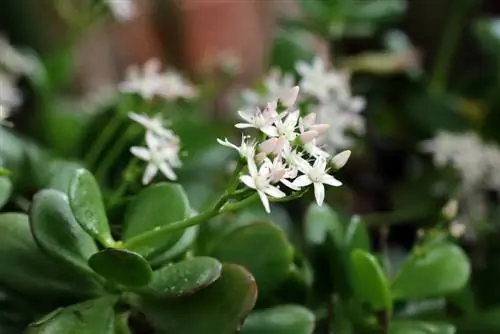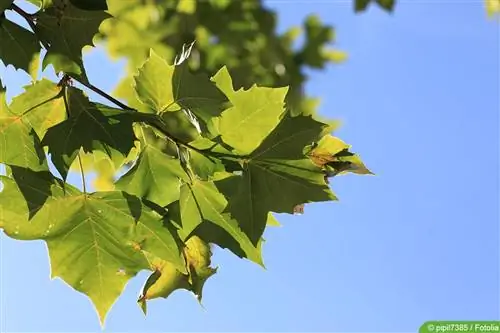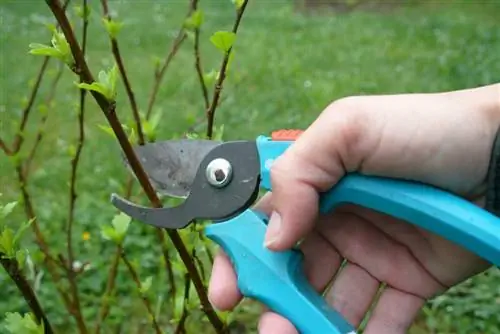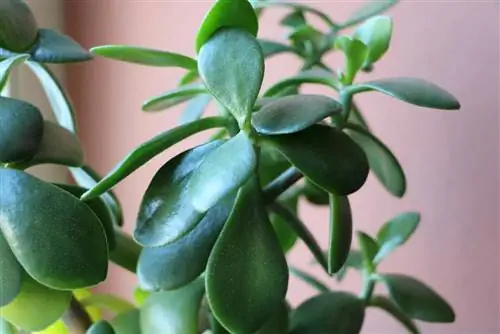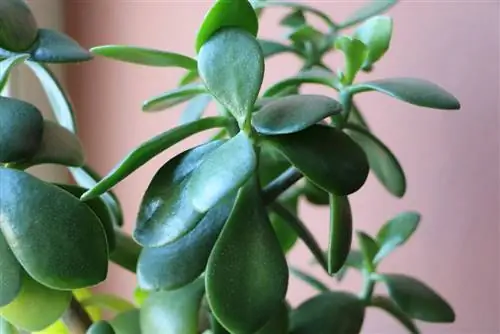- Author admin [email protected].
- Public 2023-12-17 03:39.
- Last modified 2025-01-24 12:45.
Although the money tree does not produce banknotes, the plant is still a popular houseplant. This is due to the robust characteristics of this plant, which requires little care and can grow up to 2.5 meters tall. Cutting measures are usually not necessary. But they support plant growth and create unique shapes that deviate from the bush-like original form.
The ideal cutting tool
The penny tree is one of the thick-leaved plants that develop succulent shoots. These only become woody at a later age. Scissors should not be used for cutting as they cause bruising. The cut site tends to bleed, severely weakening the plant. Injuries to the plant tissue result in brown spots that look unsightly. Therefore, use a sharp knife to get a clean cut without causing injuries. Disinfecting the blade is important to reduce the risk of disease:
- Dipping bath in high-percentage alcohol
- ten-minute bath in boiling water
- spray with disinfectant
The right cutting technique
A money tree can be pruned in different ways, combining different techniques. The first cut shapes the later growth habit. Since Crassula ovata is considered to tolerate pruning very well, you can cut off annoying shoots all year round if necessary or shape the plant. With a generous, once-a-year cut before the new growth phase, you can save the exotic plant a lot of stress. She can put her energy into developing fresh shoots during the summer.
Demand cut
If leaves wither or shoots look unsightly, you can cut them back as desired. This also applies to withered flowers that the baobab tree develops outdoors in summer. However, there is no need. If the thick-leaf plant suffers from diseases or pests, the affected parts of the plant should be removed in good time. For plants that are too heavily infested, only radical pruning usually helps.
Rejuvenating cut
Even if the baobab tree receives optimal care and the site conditions are good, older specimens in particular only produce sparse leaves. Overall, the plants appear bare or the inside of the crown is thinned out because the leaves here hardly receive any light. A rejuvenating cut revitalizes the plant and gives it new life force. It can branch out again and the nutrient supply works better again in fresh shoots. The light can penetrate back to the main stem and promote leaf growth. Overall, regular pruning makes the plant more robust and less sensitive to diseases and pests. This is how you proceed with rejuvenation pruning:
- cut old branches down to the base of the trunk
- shorten light branches by a third
- at least two pairs of leaves should remain on the shoots
- completely remove dried, discolored or diseased shoots
Shaping cut
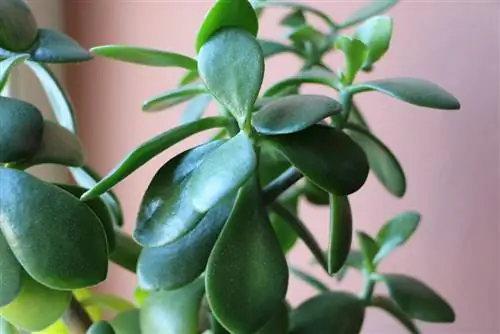
This measure is suitable for you if you want to shape your penny tree into a specific shape or maintain it. It can also be used if the plant is growing unevenly due to a suboptimal location. If it is only exposed to half of the sun and never turned, it will grow one-sided. Position the cutting tool so that the branch is not left completely bare. If a cut shoot is to branch, it needs a few pairs of leaves. Parenting cuts look like this:
- upright growth: cut all side shoots in half
- wide growth: Shorten the trunk by a third and trim branches at the top
- Compact shape: Cut hanging branches three centimeters before bending
- even shape: Shorten the branches of the denser side to the branch length of the weaker half
Tip:
Drooping branches of old specimens can also be tied up with a rope. After a while they automatically grow higher.
Breeding high stem
A money tree naturally forms highly branched and bush-like shoots. In order for the plant to resemble a small tree that develops a dense crown, you need to carry out regular pruning. Young plants that are one to two years old are well suited to this training because older plants have already developed woody trunks. Choose the strongest trunk and remove leaves and shoots in the lower area up to the height at which the crown should start. As soon as new shoots appear in this section of the trunk, remove them. Cut the shoot tips in the crown area so that the shoots branch out. Support the trunk with a stick while the plant cannot yet support its crown on its own.
Shaping Bonsai
The baobab tree offers an ideal introduction to learning the art of bonsai design. He is frugal and forgives you for incorrect pruning measures. By cutting regularly you can precisely determine the shape of the mini tree. A younger head cutting is ideal for this project. Remove the side shoots along the main trunk that are not used to form the crown. The shoots of the crown are shortened. Pay attention to a harmonious shape. Disturbing shoots are completely removed immediately after they appear. As soon as the crown branches have more than ten pairs of leaves, they are shortened.
Tip:
To get an upright growing bonsai, tie the shoots up. Curved shapes can be created with a wire.
Radical Cut
If your penny tree has been attacked by pests or diseases so that its growth potential is severely impaired, you should think about radical pruning. Even if this measure worries you, Crassula ovata can cope with intensive pruning without any problems. The measure stimulates the metabolism so that your money tree recovers more quickly from the consequences of illness or pest infestation. The plant produces new shoots in the same year. With good care and optimal site conditions, the tree has completely revitalized itself after just three years and is growing with new vigor. Do this:
- cut all branches except for one or two centimeters before branching
- If the trunk is damaged, shorten it to just above the second side shoot
- Larger trees can be trimmed to within a hand's breadth of the substrate

